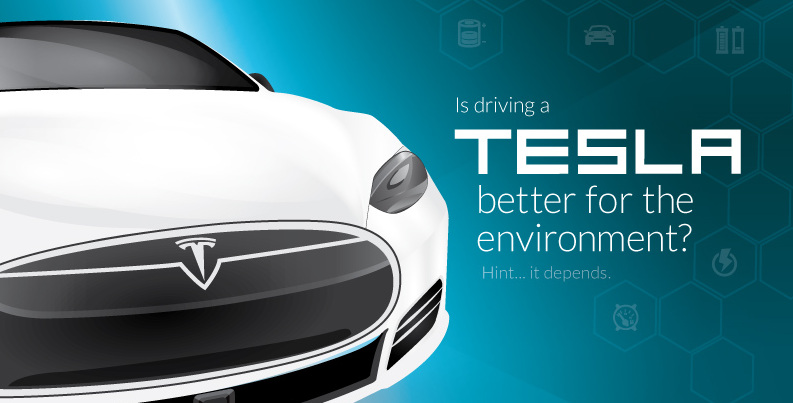Energy
Is Driving a Tesla Better for the Environment? It Depends…
Are Teslas and other electric vehicles perfect for the environment?
The answer is “no”, since nothing can be perfect. Electric vehicles are still a source of GHG emissions as a result of the manufacturing and raw material extraction processes. Further, and more importantly, lifetime emissions for electric vehicles also depend on the sources of fuel used to power the local grid.
So Is Driving a Tesla Better for the Environment?
Today’s infographic, which looks at the well-to-wheels impact of electric and gas vehicles, was created in association with Delbrook Capital, a financial services company that has launched the CO2 Master Solutions Fund.
Together we explore the latest data on the lifetime emissions of gasoline and electric vehicles, and how they compare depending on the state you live in:
Is driving a Tesla better for the environment than using a comparably sized gas-powered vehicle? In the majority of places, the answer is “yes”.
However, the true environmental impact depends greatly on the specific power sources that the local grid uses to generate electricity.
The Power Mix
According to a study done by the Union of Concerned Scientists, the average new gasoline vehicle generates the equivalent of 29 MPG of emissions over its lifetime. The study found that the average electric vehicle has emission equivalents in a range between 35 MPG to 135 MPG depending on the local power grid of the state it is driven in.
Electric cars driven in the Pacific Northwest states, as an example, have the emissions of an equivalent 94 MPG gas-powered car. This is miles better than a new Honda Fit (36 MPG) or even hybrids such as the Prius (50 MPG) or Honda Accord hybrid (47 MPG). This is because 52% of all power in the region comes from hydro.
In Colorado, about 70% of all electricity is coal-fired. This means that the electric car has the equivalent emissions of a gas-powered Honda Fit with 35 MPG. In Florida, natural gas has replaced coal usage, and now accounts for two-thirds of all electricity generated. Powering an EV on Florida’s grid for an estimated 51 MPG equivalent is better than driving a hybrid such as a Prius (50 MPG) or a Honda Accord Hybrid (47 MPG).
The Future of Emissions
Today, the study by the Union of Concerned Scientists concludes that 66% of Americans definitely would generate less emissions by driving electric vehicles based on the compositions of their local power grids.
In the very near future, plugging in will be better in 100% of places in America. Here’s why:
- Battery technology will continue to get better. More efficiency means lighter and better cars.
- Coal is falling. It’s gone from 44% of all U.S. power generation in 2009 to 33% in 2015. It’s forecasted to fall to 22% by 2020.
- Many states also have committed to specific targets for green energy as a portion of their energy mix. More renewables for the grid means less emissions.
For investors, these changes will create many opportunities for investors.
As the electric car era is ushered in, some experts are predicting that entire power grids will need to be re-wired to accommodate. Automobile dealer networks will be profoundly affected.
Car part manufacturers will also have to adapt. How many pieces are in a typical gas-powered vehicle? According to energy expert Gianni Kovacevic there are about 100.

In an electric vehicle, which only needs about 20 components, many of these parts such as pistons and spark plugs will become antiquated.
Energy
The World’s Biggest Nuclear Energy Producers
China has grown its nuclear capacity over the last decade, now ranking second on the list of top nuclear energy producers.

The World’s Biggest Nuclear Energy Producers
This was originally posted on our Voronoi app. Download the app for free on Apple or Android and discover incredible data-driven charts from a variety of trusted sources.
Scientists in South Korea recently broke a record in a nuclear fusion experiment. For 48 seconds, they sustained a temperature seven times that of the sun’s core.
But generating commercially viable energy from nuclear fusion still remains more science fiction than reality. Meanwhile, its more reliable sibling, nuclear fission, has been powering our world for many decades.
In this graphic, we visualized the top producers of nuclear energy by their share of the global total, measured in terawatt hours (TWh). Data for this was sourced from the Nuclear Energy Institute, last updated in August 2022.
Which Country Generates the Most Nuclear Energy?
Nuclear energy production in the U.S. is more than twice the amount produced by China (ranked second) and France (ranked third) put together. In total, the U.S. accounts for nearly 30% of global nuclear energy output.
However, nuclear power only accounts for one-fifth of America’s electricity supply. This is in contrast to France, which generates 60% of its electricity from nuclear plants.
| Rank | Country | Nuclear Energy Produced (TWh) | % of Total |
|---|---|---|---|
| 1 | 🇺🇸 U.S. | 772 | 29% |
| 2 | 🇨🇳 China | 383 | 14% |
| 3 | 🇫🇷 France | 363 | 14% |
| 4 | 🇷🇺 Russia | 208 | 8% |
| 5 | 🇰🇷 South Korea | 150 | 6% |
| 6 | 🇨🇦 Canada | 87 | 3% |
| 7 | 🇺🇦 Ukraine | 81 | 3% |
| 8 | 🇩🇪 Germany | 65 | 2% |
| 9 | 🇯🇵 Japan | 61 | 2% |
| 10 | 🇪🇸 Spain | 54 | 2% |
| 11 | 🇸🇪 Sweden | 51 | 2% |
| 12 | 🇧🇪 Belgium | 48 | 2% |
| 13 | 🇬🇧 UK | 42 | 2% |
| 14 | 🇮🇳 India | 40 | 2% |
| 15 | 🇨🇿 Czech Republic | 29 | 1% |
| N/A | 🌐 Other | 219 | 8% |
| N/A | 🌍 Total | 2,653 | 100% |
Another highlight is how China has rapidly grown its nuclear energy capabilities in the last decade. Between 2016 and 2021, for example, it increased its share of global nuclear energy output from less than 10% to more than 14%, overtaking France for second place.
On the opposite end, the UK’s share has slipped to 2% over the same time period.
Meanwhile, Ukraine has heavily relied on nuclear energy to power its grid. In March 2022, it lost access to its key Zaporizhzhia Nuclear Power Station after Russian forces wrested control of the facility. With six 1,000 MW reactors, the plant is one of the largest in Europe. It is currently not producing any power, and has been the site of recent drone attacks.
-

 Markets2 weeks ago
Markets2 weeks agoVisualizing America’s Shortage of Affordable Homes
-

 Technology1 week ago
Technology1 week agoRanked: Semiconductor Companies by Industry Revenue Share
-

 Money1 week ago
Money1 week agoWhich States Have the Highest Minimum Wage in America?
-

 Real Estate1 week ago
Real Estate1 week agoRanked: The Most Valuable Housing Markets in America
-

 Business2 weeks ago
Business2 weeks agoCharted: Big Four Market Share by S&P 500 Audits
-

 AI2 weeks ago
AI2 weeks agoThe Stock Performance of U.S. Chipmakers So Far in 2024
-

 Automotive2 weeks ago
Automotive2 weeks agoAlmost Every EV Stock is Down After Q1 2024
-

 Money2 weeks ago
Money2 weeks agoWhere Does One U.S. Tax Dollar Go?














